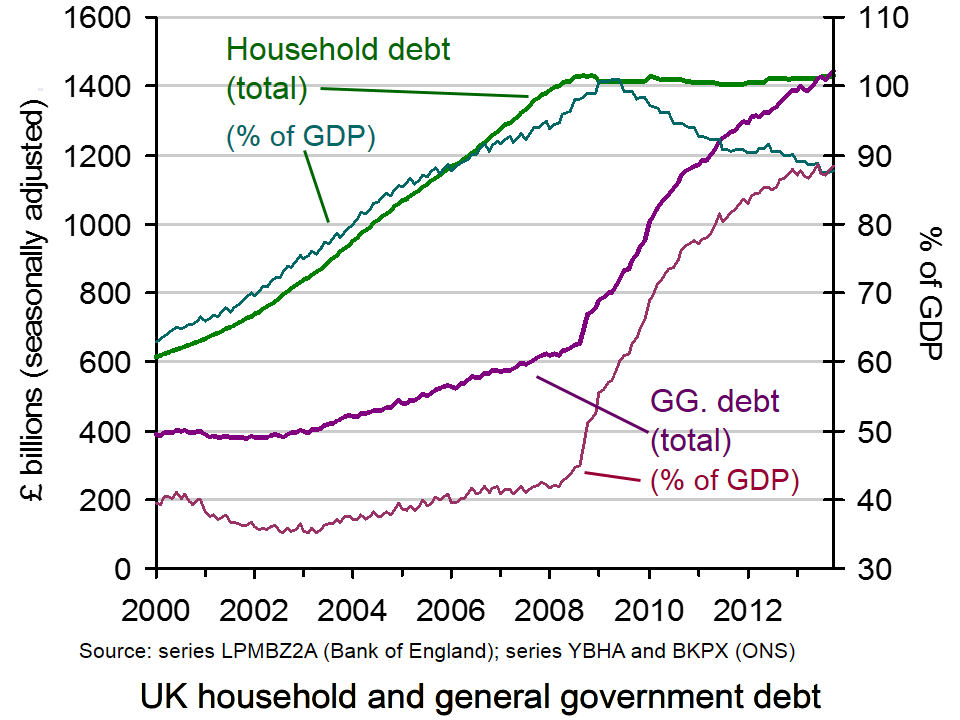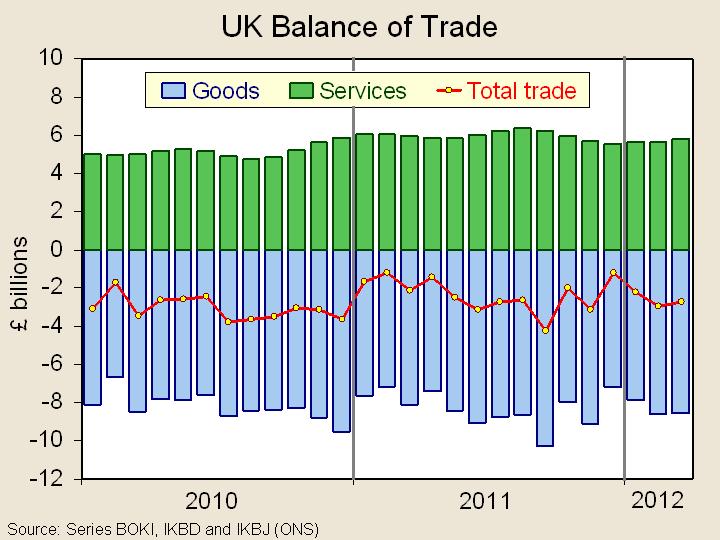 Household debt in the UK has reached a record level. Individuals now owe £1430 billion. This compares with the UK’s general government debt of £1443 billion – also at a record level. These figures are illustrated in the chart (click here for a PowerPoint).
Household debt in the UK has reached a record level. Individuals now owe £1430 billion. This compares with the UK’s general government debt of £1443 billion – also at a record level. These figures are illustrated in the chart (click here for a PowerPoint).
But these figures are nominal. If you look at the real figures (i.e. corrected for inflation), household debt has been falling. In today’s prices, household debt peaked at £1668 billion in March 2008. Also, if you look at household debt as a proportion of GDP, it fell from a peak of 100.96% in May 2009 to 87.43% in July 2013 (see chart). However, since then it has begun rising again, standing at 87.65% in October 2013.
So has household debt become less of a problem? In aggregate terms, the answer is probably yes. However, it is too early to know whether a continuing recovery in the economy will be fuelled by real debt rising again and whether the recovery will encourage people to take on higher levels of debt?
For many people, however, debt has become more and more of a problem. In other words, the aggregate figures conceal what has happened in terms of the distribution of debt. According to a Centre for Social Justice (CSJ) study:
Indebted households in the poorest 10 per cent of the country have average debts more than four times their annual income. Average debt repayments within this group amounted to nearly half their gross monthly income.

And the poorest families, often with very poor credit ratings, are frequently forced to turn to payday lenders, charging sky-high interest rates (see Capping interest rates on payday loans: a government U-turn?).
As mainstream banks reduced access to credit following the financial crash, the market for short-term high-cost credit (payday lenders, pawnbrokers, rent-to-buy and doorstop lenders) increased dramatically and is now worth £4.8 billion a year.
Payday lenders have increased business from £900 million in 2008/09 to just over £2 billion (or around 8 million loans) in 2011/12. Around half of payday loan customers reported taking out the money because it was the only form of credit they could get. The number of people going to loan sharks is also said to have increased – the most recent estimate puts it at 310,000 people.
With rising energy and food bills hitting the poorest hardest, this section of the population could find debt levels continuing to rise, especially if interest rates rise. As Chris Pond, who chaired the CJS study, stated:
The costs to those affected, in stress and mental disorders, relationship breakdown and hardship is immense. But so too is the cost to the nation, measured in lost employment and productivity and in an increased burden on public services.
Articles
£1,430,000,000,000 (that’s £1.43 trillion): Britain’s personal debt timebomb Independent, Andrew Grice (20/11/13)
Average household debt ‘doubled in last decade’ The Telegraph, Edward Malnick (20/11/13)
UK household debt hits record high BBC News (29/11/13)
UK debt crisis: poorest face ‘perfect storm’ Channel 4 News (20/11/13)
One in five struggle with serious debt The Telegraph, Nicole Blackmore (27/11/13)
It doesn’t matter what we do with Wonga: personal debt is about to rocket The Telegraph, Tim Wigmore (26/11/13)
Poorest families ‘need more help over debt’ BBC News (20/11/13)
Report
More than 5,000 people a year ‘homeless’ as household debt crisis deepens, CSJ warns Centre for Social Justice Press Release (20/11/13)
Data
Monthly amounts outstanding of total (excluding the Student Loans Company) sterling net lending to individuals and housing associations (in sterling millions) seasonally adjusted Bank of England
Public Sector Finances First Release – Public Sector Consolidated Gross Debt ONS
Household debt (Economics Indicators update) House of Commons Library (29/11/13)
Questions
- What are the macroeconomic implications of rising levels of household debt?
- Why may an economy which has high levels of household debt be more subject to cyclical fluctuations in real GDP?
- What are the problems of having a recovery driven largely by increased consumer expenditure?
- Why have many people in the poorest sectors of society found their debt levels rising the fastest?
- Why may rising levels of debt of the most vulnerable people make it harder for the Bank of England to use conventional monetary policy if recovery becomes established?
- What policies could be pursued to try to reduce the debts of the poorest people?
- Discuss the effectiveness of these various policies.
 The UK’s trade deficit narrowed in March to £2.74bn from £2.95bn in February. The goods deficit fell just slightly to £8.56bn from £8.59bn, but the services surplus rose more substantially to £5.83bn from £5.64bn.
The UK’s trade deficit narrowed in March to £2.74bn from £2.95bn in February. The goods deficit fell just slightly to £8.56bn from £8.59bn, but the services surplus rose more substantially to £5.83bn from £5.64bn.
So was this a sign of the UK economy’s relative weakness holding back the demand for imports? Or was it a sign of a recovering export sector, especially in services?
 And what of the coming months? What will be the effect of a growing crisis in the eurozone on (a) the sterling exchange rate, (b) the rate of economic growth outside the UK and (c) UK economic growth? And what will be the effect of these on the demand for imports and exports and on the trade balance? The following articles examine the issues.
And what of the coming months? What will be the effect of a growing crisis in the eurozone on (a) the sterling exchange rate, (b) the rate of economic growth outside the UK and (c) UK economic growth? And what will be the effect of these on the demand for imports and exports and on the trade balance? The following articles examine the issues.
(For a PowerPoint of the above chart, click on the following link: Balance of trade)
Articles
UK goods trade deficit stable as exports to non-EU countries rebound Reuters (15/5/12)
UK trade deficit narrows in March to £2.7bn BBC News (15/5/12)
Exports close UK trade deficit Guardian (15/5/12)
First trade surplus in cars since 1976 The Telegraph, Emma Rowley (15/5/12)
UK trade deficit narrows in March Fresh Business Thinking, Marcus Leach (15/5/12)
ONS Release
UK Trade, March 2012 ONS Release (15/5/12)
Questions
- Distinguish between the balance on trade in goods, the balance of trade and the balance on current account.
- Why did the UK’s trade deficit fall in March 2012?
- Why did the UK experience its first trade surplus in cars since 1976?
- What is likely to happen to the UK’s balance of trade in the coming months? How is the income elasticity of demand for UK exports and imports relevant to the answer?
- What has been happening recently to the sterling exchange rate? How will this impact on the UK’s balance of trade? How will the size of this impact depend on the price elasticity of demand and supply for imports and exports?
The International Monetary Fund consists of 187 countries and is concerned with its members’ economic health. It promotes co-operation, economic stability and is also there to lend to those countries facing difficulties. The role of the IMF as a lender has come into question, as critics argue that the conditions placed on loans to countries can cause more problems than they solve, as the cause of the problems is not always identified. However, despite the criticisms and the current charges facing the former IMF Chief, the International Monetary Fund continues to play an important role in the global economic environment.
Many countries have used IMF credit and over the past two decades it has predominantly been the transition and the emerging market economies that have demanded the IMF’s resources. Whilst its lending did drop off in the mid 2000s, the global financial crisis of 2008/09 saw an increase in the demand for IMF funds from emerging economies to some $60 billion. In May 2010, we saw the IMF together with the EU put together a rescue package for Greece and it is now the turn of Egypt. The uprisings in Egypt put the stability of the economy in jeopardy, as investment declined, tax revenues decreased and the usually buoyant tourist industry started to struggle. Despite the efforts of the government to stabilise the economy, it remains short of cash and the IMF looks set to agree a loan deal of $3 billion (£1.8 billion). Egypt would have five years to repay the loan at an interest rate of 1.5%, after a three year ‘grace period’.
Other countries to receive loans include Ireland, Belarus, the Ukraine and Iceland, the latter of which owes the IMF $2,828.67 per person of its population. The UK has used the IMF back in 1976 and it may be something to look out for, depending on how our recovery continues. The following articles look at the IMF and its role in promoting global financial stability.
Articles
IMF to lend Egypt $3 bn: Ministry Associated Press (6/5/11)
IMF agrees $3bn financing deal with Egypt BBC News (5/6/11)
Timeline: Greece’s debt crisis Reuters (5/6/11)
Egypt strikes $3bn IMF deal to ‘re-launch’ economy Guardian, Jack Shenker (5/6/11)
The IMF versus the Arab Spring Guardian, Austin Mackell (25/5/11)
EU/IMF/ECB statement on Greek bailout Reuters (3/6/11)
Belarus wins $3 billion loan from Russia-led fund, still seeks IMF’s help Bloomberg, Scott Rose and Daryna Krasnolutska (4/6/11)
IMF frees up $225mn for Iceland Associated Press (4/6/11)
IMF loan: which country owes the most? Guardian (24/5/11)
International Monetary Fund
International Monetary Fund Homepage
IMF outlines $3 billion support for Egypt International Monetary Fund, IMF Survey Online (5/6/11)
Questions
- What is the role of the IMF and how is it financed?
- What are the objectives of the loans to countries such as Greece, Iceland and Egypt?
- What other countries has the IMF lent to and what are the conditions that have been placed on these loans?
- What has been the impact on the Egyptian economy of the uprisings? Think about all the industries that have been affected and the wider impacts.
- Can you find any examples of circumstances in which the conditions of an IMF loan have made problems worse for the recipient?
- Why are the conditions of the IMF loan to Egypt favourable and how will the loan help the economy?
- Look at the trend in IMF lending. What factors explain the peak and troughs? In particular, what is the explanation for the incresae in lending during the financial crisis?
The banking sector was at the heart of the credit crunch and it may also be at the heart of the recovery. Too much lending to those who could not repay has now translated into government encouragement and targets to stimulate further lending. Banks made a deal with the government (Project Merlin) to lend £76bn to small and medium sized companies (SMEs) in 2011, however, the data for the first quarter of 2011 shows that the top five UK banks lent only £16.8bn, some £2.2bn short of their quarterly target (about 12%). Despite this sum still being a significant figure, small companies have said that they are still finding it difficult to obtain credit from banks. A poll found 44% of companies that asked for a loan were turned down and many were discouraged from even applying as they had almost no chance.
Encouraging banks to lend and hence stimulating investment by businesses may prove crucial to the UK’s recovery. Vince Cable’s words with regard to lending emphasise its importance:
“We will monitor the banks’ performance extremely closely and if they fail to meet the commitments they have agreed we will examine options for further action.”
If small businesses can obtain credit, it will help them to develop and expand and this should have knock on effects on the rest of the economy. Jobs could be created, giving more people an income, which in turn should stimulate consumption, further investment and finally aggregate demand. It may not be the case that the UK’s recovery is entirely dependent on bank lending, but it could certainly play an important role, hence the government’s insistence for further lending. It may also act to create confidence in the economy. The following articles consider the bank’s role in providing credit to SMEs.
Articles
Bank lending falling short of promises by £25m a day Mail Online, Becky Barrow (24/5/11)
Cable tells banks to increase lending to small firms BBC News (23/5/11)
Bank lending targets: What the experts say Guardian, Alex Hawkes (23/5/11)
Major banks fail to meet their lending targets Independent, Sean Farrell (24/5/11)
Banks on course to miss small business lending target Guardian, Philip Inman (23/5/11)
Project Merlin needs to be less woolly and more wizard Guardian, Nils Pratley (23/5/11)
Bankers caused the crash and now they strangle recovery Guardian, Polly Toynbee (27/5/11)
Data
Trends in Lending Bank of England (see in particular, Lending to UK Businesses)
Questions
- Why have banks not met their lending targets for the first quarter of 2011?
- Why is project Merlin so potentially important to the recovery of the economy?
- Using an AD/AS diagram, illustrate the possible effects of further lending.
- Are there any possible adverse consequences of too much lending?
- Why might banks have little incentive to increase their lending to SMEs?
With an election approaching, there is much debate about recovery and cuts and about the relationships between the two. Will rapid cuts stimulate confidence in the UK by business and bankers and thereby stimulate investment and recovery, or will they drive the economy back into recession? The debate is not just between politicians vying for your vote; economists too are debating the issue. Many are taking to letter writing.
In the February 2010 news blog, A clash of ideas – what to do about the deficit, we considered three letters written by economists (linked to again below). There has now been a fourth – and doubtless not the last. This latest letter, in the wake of the Budget and the debates about the speed of the cuts, takes a Keynesian line and looks at the sustainability of the recovery – including social and environmental sustainability. It is signed by 34 people, mainly economists.
Letter: Better routes to economic recovery Guardian (27/3/10)
Letter: UK economy cries out for credible rescue plan Sunday Times, 20 economists (14/2/10)
Letter: First priority must be to restore robust growth Financial Times, Lord Skidelsky and others (18/2/10)
Letter: Sharp shock now would be dangerous Financial Times, Lord Layard and others (18/2/10)
Questions
- Summarise the arguments for making rapid cuts in the deficit.
- Summarise the arguments for making gradual cuts in the deficit in line with the recovery in private-sector demand.
- Under what conditions would the current high deficit crowd out private expenditure?
- What do you understand by a ‘Green New Deal’? How realistic is such a New Deal and would there be any downsides?
- Is the disagreement between the economists the result of (a) different analysis, (b) different objectives or (c) different interpretation of forecasts of the robustness of the recovery and how markets are likely to respond to alternative policies? Or is it a combination of two of them or all three? Explain your answer.
- Why is the effect of the recession on the supply-side of the economy crucial in determining the sustainability of a demand-led recovery?
 Household debt in the UK has reached a record level. Individuals now owe £1430 billion. This compares with the UK’s general government debt of £1443 billion – also at a record level. These figures are illustrated in the chart (click here for a PowerPoint).
Household debt in the UK has reached a record level. Individuals now owe £1430 billion. This compares with the UK’s general government debt of £1443 billion – also at a record level. These figures are illustrated in the chart (click here for a PowerPoint).

